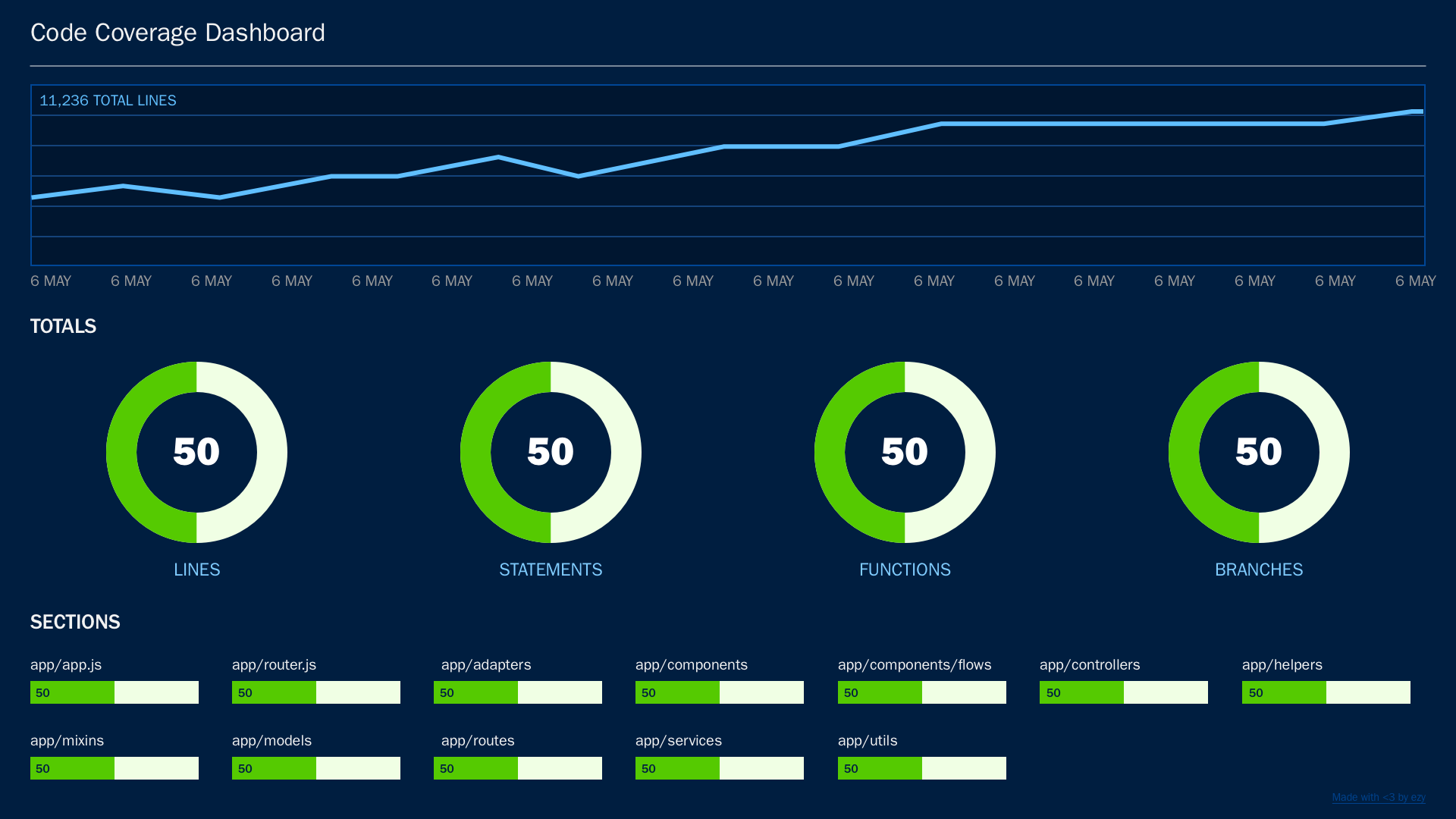https://github.com/ezy/code-coverage-dashboard
🚦A dashboard for displaying code coverage reports generated by Istanbul.js
https://github.com/ezy/code-coverage-dashboard
code-coverage coverage coverage-report d3js dashboard istanbuljs react reactjs
Last synced: 3 months ago
JSON representation
🚦A dashboard for displaying code coverage reports generated by Istanbul.js
- Host: GitHub
- URL: https://github.com/ezy/code-coverage-dashboard
- Owner: ezy
- Created: 2018-08-21T00:13:37.000Z (almost 7 years ago)
- Default Branch: master
- Last Pushed: 2018-08-23T01:17:13.000Z (almost 7 years ago)
- Last Synced: 2025-03-24T16:41:15.326Z (3 months ago)
- Topics: code-coverage, coverage, coverage-report, d3js, dashboard, istanbuljs, react, reactjs
- Language: JavaScript
- Homepage:
- Size: 291 KB
- Stars: 4
- Watchers: 2
- Forks: 2
- Open Issues: 0
-
Metadata Files:
- Readme: README.md
Awesome Lists containing this project
README
# 🚦 Code Coverage Dashboard
A simple dashboard for [Istanbul](https://github.com/gotwarlost/istanbul) code coverage reports designed to be deployed to Heroku. The app takes any `coverage-summary.json` input file hosted within a folder on github and displays the data in a set of easily configurable chart components. Works great for a dev team to see their code coverage improving over time.

## Table of Contents
- [Quick start](#quick-start)
- [Istanbul setup](#istanbul-setup)
- [Configuring reports](#configuring-reports)
- [Available scripts](#available-scripts)
## Quick start
- Setup [Istanbul](https://github.com/gotwarlost/istanbul) to export a `json-summary` report with datestamp.
- Upload `coverage-summary-1534886771995.json` to a folder in the github repo you want to display.
- Add the folder location of your `json-summary` report in .env `REACT_APP_DATA_DIR_URL`.
- Build to Heroku.
- The app will check hourly for a new file in `REACT_APP_DATA_DIR_URL`.
- If the filename is different (eg. `coverage-summary-1534886791867.json`) the line chart will update.
## Istanbul setup
Reports are generated from the `json-summary` report by Istanbul. There's an example `isantbul.yml` file in the project directory that includes report settings for `html` and `json-summary` reports. In order for your filename changes to be picked up you can timeStamp the `coverage-sumary.json` file by using the following script in your `package.json` file:
```JSON
{
"scripts": {
"covdate": "mv coverage/coverage-summary.json coverage/coverage-summary-$(date +%Y%m%d%H%M).json"
}
}
```
## Configuring reports
There are three different report charts that are displayed: A dateTime based **line chart** displaying total statement coverage; a summary of total coverage values as **donut charts**; and a group of **stack charts** that display coverage for individual and grouped report strings.
### Line chart
The line chart component is located at `src/components/LineChart.js`. It takes an array of values from `localStorage` and displays them as date (X axis) and value (Y axis) from the object input: `{value: 96.75, date: "2018-08-21T04:13:07.414Z"}`. All localStorage values are loaded in the `src/templates/App.js` file.
### Donut chart
The donut chart is fixed and takes the JSON fetched from `coverage-summary.json` as `data` props. It's currently hard-coded to display the percentage of the report totals with the `selectName` property for the corresponding nested key in the `total` object.
eg. ``
### Stack chart
The stack charts take the JSON fetched from `coverage-summary.json` as `data` props. They take a second property `fileSet` that can be specified as all or part of the object key strings in `coverage-summary.json`. The stack chart will display the average coverage for an keys that match the `fileSet` property.
eg. ``
## Available scripts
In the project directory, you can run:
### `yarn start`
Runs the app in the development mode.
Open [http://localhost:3000](http://localhost:3000) to view it in the browser.
The page will reload if you make edits.
You will also see any lint errors in the console.
### `yarn test`
Launches the test runner in the interactive watch mode.
### `yarn build`
Builds the app for production to the `build` folder.
It correctly bundles React in production mode and optimizes the build for the best performance.
The build is minified and the filenames include the hashes.
Your app is ready to be deployed!
### `yarn lint`
Runs linting for the project and checks against rules in `.eslintrc.json`.